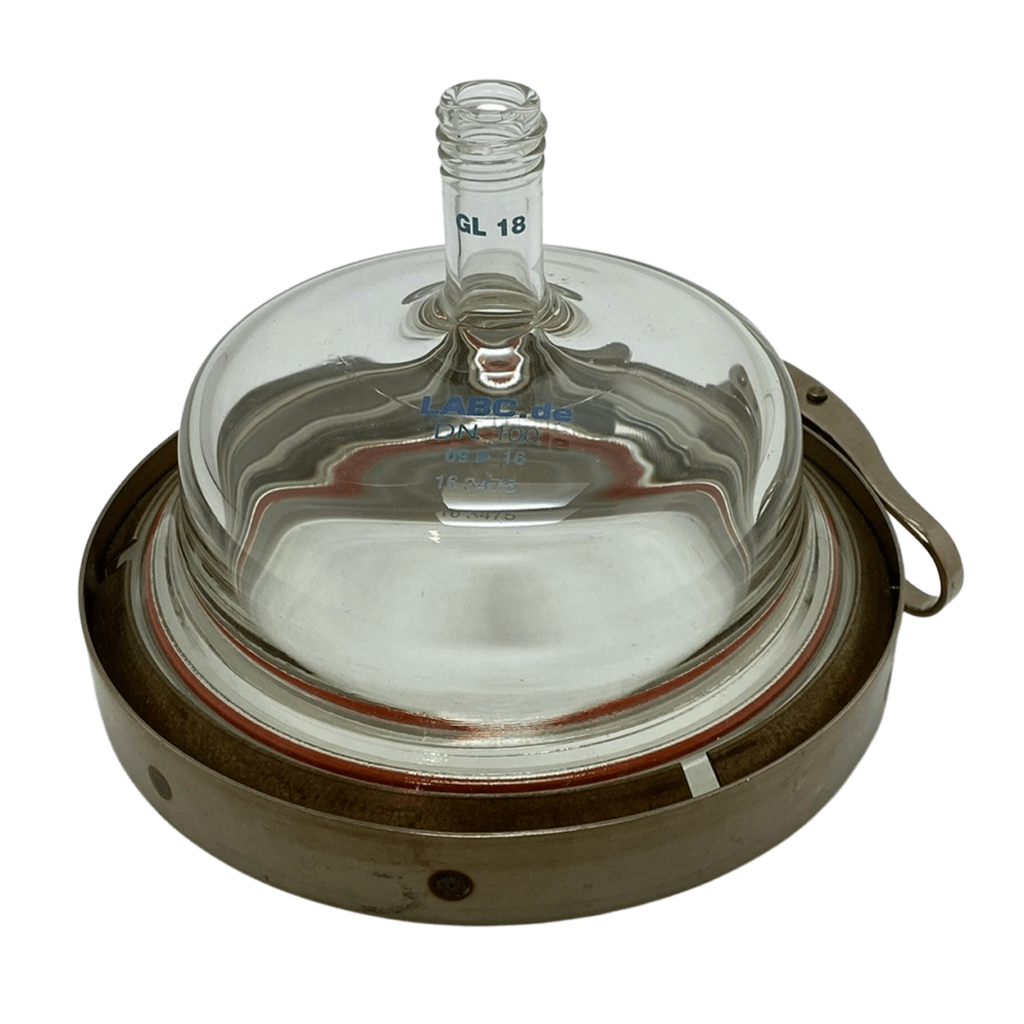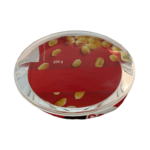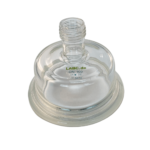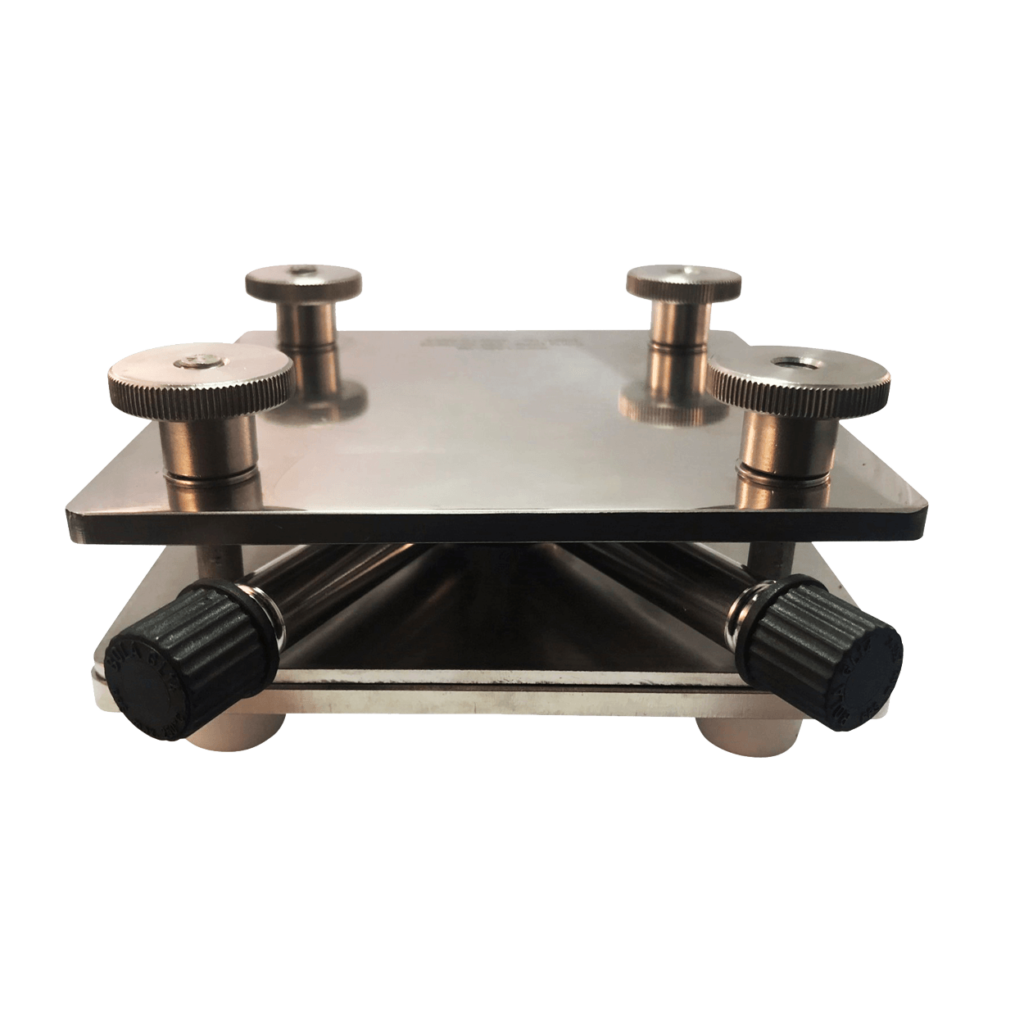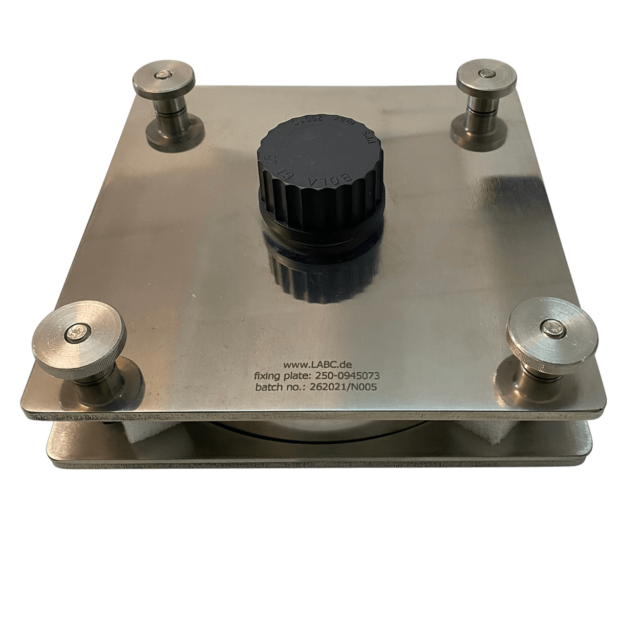Migration cell “MigraCubicle
Overview
The migration cell system “MigraCubicle” is a test chamber made entirely of borosilicate glass.
“MigraCubicle” was developed in accordance with cell type D (figure C.6, EN1186-1:2002). “MigraCubicle” is available in different sizes and can be adapted to different test piece sizes. The glass cells are used, for example, when testing with the food simulants MPPO (Tenax®), 3% acetic acid and oil
Migration tests are carried out as simulation experiments. These are best carried out using special migration cells. It has proven successful not to work with migration cells of a certain standard size, but to use cells of different sizes and materials appropriate to the problem. The advantage of a migration cell is that really one-sided contact can be readjusted without cutting edges or other effects. In order to achieve comparable results, the tests are carried out under standardized test conditions,
such as test duration, test temperature and test medium (food simulant), which correspond to the most unfavourable and foreseeable conditions of use of the plastic material or object. Migration cells and the performance of migration analyses are described in standards EN1186 and EN13130, among others. “MigraCubicle” was developed in accordance with cell type D (figure C.6, EN1186-1:2002).
Migration cell "MigraCubicle
Migration cells system “MigraCubicle” – based on cell type D (figure C.6, EN1186-1:2002) made of borosilicate glass are classic migration chambers. It enables reproducible sample preparation of migration measurements. The migration cells made of DURAN® glass have proven their worth for the experimental detection of mass transfer of packaging ingredients from consumer goods to solid food test simulants, such as Tenax, and liquid food test simulants (3% acetic acid, water and oil, such as olive oil or sunflower oil). Very smooth and thin films as well as 2 – 4 mm thick polystyrene foam (e.g. from menu boxes) can be processed with one-sided contact in the “MigraCubicle” migration cell system.
The Sieg-Mi-Flex migration cells are better suited for liquid food simulants – even above their boiling point.
Legal basis Migration
Application area "MigraCubicle
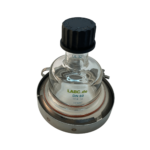
The “MigraCubicle” migration cell system is very well suited for use with the solid food simulant MPPO = modified polyphenylene oxide, e.g. poly(2,6-diphenyl-p-phenylene oxide), particle size 60 – 80 mesh, pore size 200 nm MPPO (Tenax®, REGULATION (EU) No. 10/2011(PIM)) and for the examination of samples from polystyrene foam menu boxes (no O-sealing ring is used here, which also changes the surfaces). If the migration cell system “MigraCubicle” is filled with liquid food simulants, losses of the liquid simulants may occur depending on the cell size, the test temperature, the surface tension or viscosity, as well as the thickness and condition of the samples to be tested. Practical tip: For very thin and smooth films, placing laboratory aluminum foil or pure filter paper under the sample ensures a better seal.
Structure of the "MigraCubicle
Migration cell system “MigraCubicle” consisting of:
- Quick release fastener made of CrNi steel
- solid glass base made of DURAN® glass,
- Glass lid with GL thread centrically (z) or laterally (s) made of DURAN® glass
- Choice between Gl-18 or GL-32 thread
- O-ring made of seamless silicone rubber coated with FEP* (FEP*/Sil, (FEP* = Fluorinated Ethylene Propylene)).
- one GL screw cap made of PPS black, without hole with inserted PTFE-coated silicone rubber gasket
"MigraCubicle" glass base
The base of the “MigraCubicle” is a solid plate made of DURAN® borosilicate glass-3.3. The glass plate is several centimetres thick and made of crystal-clear and translucent borosilicate glass. The glass lets UV radiation through unfiltered. The samples lie on the glass plate. Furthermore, the migration cell system “MigraCubicle” has a high stability due to the solid base plate and requires little space in the drying cabinet due to its low design.
Glass lid of the "MigraCubicle
The glass lid is made of DURAN® glass. Three variants with GL thread are available. The thread can be centric (z) or lateral (s). With the centric glass lid, you also have the choice between a GL18 and a GL32 thread. Basically, it should be noted that it is easier to fill in the migration emulsion with a centric thread. Side-mounted threads make the migration cell more compact. One saves height and thus space in the drying cabinet.
Available variants with item number
| GL32z: | GL18z: | GL18s: | Cell Size: | Area: |
|---|---|---|---|---|
| 250-0635141 | 250-0586481 | 250-0586283 | MC 35 | 0,15 dm² |
| 250-0635172 | 250-0085885 | 250-0586252 | MC 60 | 0,5 dm² |
| 250-0635189 | 250-0586498 | 250-0586290 | MC 100 | 1 dm² |
| 250-0635196 | 250-0586504 | 250-0586542 | MC 120 | 1,5 dm² |
| 250-0635202 | 250-0586511 | 250-0586306 | MC 150 | 2 dm² |
| 250-0635219 | 250-0586528 | 250-0586313 | MC 200 | 3,5 dm² |
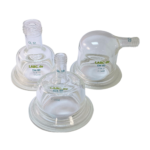 The real migration surfaces of the respective “MigraCubicle” cell size result from the inner diameters of the FEP/Sil-O sealing rings. When measuring without sealing rings (e.g. when examining menu boxes made of polystyrene foam), the areas result from the inner diameter of the glass cell lids (inner edge to inner edge!). The different diameters:
The real migration surfaces of the respective “MigraCubicle” cell size result from the inner diameters of the FEP/Sil-O sealing rings. When measuring without sealing rings (e.g. when examining menu boxes made of polystyrene foam), the areas result from the inner diameter of the glass cell lids (inner edge to inner edge!). The different diameters:
| Cell type MC: | Area: | FEP/Sil-O-ring: | Real surface with sealing ring: | Glass cell lid: | Real surface without sealing ring: |
|---|---|---|---|---|---|
| MC 35 | 0,15 dm² | Ø 0,46 dm | 0,165 dm² | Ø 0,35 dm | 0,096 dm² |
| MC 60 | 0,5 dm² | Ø 0,75 dm | 0,442 dm² | Ø 0,60 dm | 0.283 dm² |
| MC 100 | 1 dm² | Ø 1,10 dm | 0,950 dm² | Ø 1,00 dm | 0,785 dm² |
| MC 120 | 1,5 dm² | Ø 1,33 dm | 1,39 dm² | Ø 1,20 dm | 1,131 dm² |
| MC 150 | 2 dm² | Ø 1,57 dm | 1,94 dm² | Ø 1,50 dm | 1,767 dm² |
| MC 200 | 3,5 dm² | Ø 2,15 dm | 3,63 dm² | Ø 2,00 dm | 3,142 dm² |
Suitability migration cells
Experience values for the suitability of the migration cells system “MigraCubicle” depending on the medium and tests at 20 °C.
| Food simulant: | Short cut*: | MC 35 | MC 60 | MC 100 | MC 120 | MC 150 | MC 200 |
|---|---|---|---|---|---|---|---|
| Ethanol 10 % by volume | A | yes | yes | no | no | no | no |
| Acetic acid 3 % by weight | C | yes | yes | yes | yes | yes | yes |
| Ethanol 20 % by volume | D | yes | yes | no | no | no | no |
| Ethanol 50 % by volume | D1 | yes | yes | no | no | no | no |
| Vegetable oil | D2 | yes | yes | yes | no | no | no |
| MPPO | E | yes | yes | yes | yes | yes | yes |
| Water | H2O/H2O dest. | yes | yes | yes | yes | yes | yes |
| Ethanol 95 vol.-% | Substitute examinations | no | no | no | no | no | no |
| Isooctane | Substitute examinations | no | no | no | no | no | no |
* e.g.: Food simulant A
No responsibility is taken for the correctness of this information. It is essential to check the tightness on your own responsibility!
Carrying out your migration audit
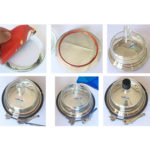 Migration tests are performed with the “MigraCubicle” with one-sided contact of the simulant with the sample. In the first step, the sample is adjusted to the dimension of the “MigraCubicle”. To do this, place the specimen on the glass plate and cut around the outside. Then place the specimen on the borosilicate plate with the correct side facing up. In the next step, the O-ring is placed on the sample and then the glass lid is put on. Make sure that the glass lid sits exactly on the glass plate and then place the clamping ring around the outside. This fixes both parts. The size of the clamping ring can be adjusted with a screw. If the clamping ring is seated cleanly on the glass plate, the food simulant is introduced via the GL opening. In the last step, the opening is closed with a screw cap and the “MigraCubicle” can be placed in the drying cabinet. Please make sure that no simulant occurs laterally!
Migration tests are performed with the “MigraCubicle” with one-sided contact of the simulant with the sample. In the first step, the sample is adjusted to the dimension of the “MigraCubicle”. To do this, place the specimen on the glass plate and cut around the outside. Then place the specimen on the borosilicate plate with the correct side facing up. In the next step, the O-ring is placed on the sample and then the glass lid is put on. Make sure that the glass lid sits exactly on the glass plate and then place the clamping ring around the outside. This fixes both parts. The size of the clamping ring can be adjusted with a screw. If the clamping ring is seated cleanly on the glass plate, the food simulant is introduced via the GL opening. In the last step, the opening is closed with a screw cap and the “MigraCubicle” can be placed in the drying cabinet. Please make sure that no simulant occurs laterally!

